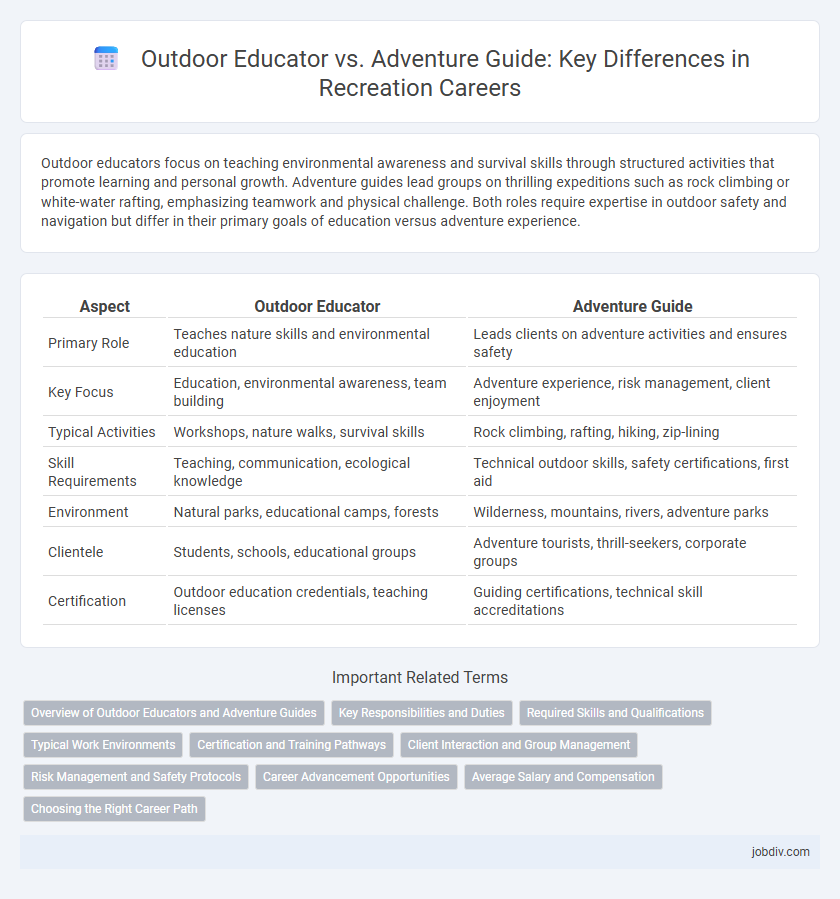Outdoor educators focus on teaching environmental awareness and survival skills through structured activities that promote learning and personal growth. Adventure guides lead groups on thrilling expeditions such as rock climbing or white-water rafting, emphasizing teamwork and physical challenge. Both roles require expertise in outdoor safety and navigation but differ in their primary goals of education versus adventure experience.
Table of Comparison
| Aspect | Outdoor Educator | Adventure Guide |
|---|---|---|
| Primary Role | Teaches nature skills and environmental education | Leads clients on adventure activities and ensures safety |
| Key Focus | Education, environmental awareness, team building | Adventure experience, risk management, client enjoyment |
| Typical Activities | Workshops, nature walks, survival skills | Rock climbing, rafting, hiking, zip-lining |
| Skill Requirements | Teaching, communication, ecological knowledge | Technical outdoor skills, safety certifications, first aid |
| Environment | Natural parks, educational camps, forests | Wilderness, mountains, rivers, adventure parks |
| Clientele | Students, schools, educational groups | Adventure tourists, thrill-seekers, corporate groups |
| Certification | Outdoor education credentials, teaching licenses | Guiding certifications, technical skill accreditations |
Overview of Outdoor Educators and Adventure Guides
Outdoor educators specialize in teaching environmental awareness, survival skills, and team-building activities in natural settings, often working with schools and youth groups to foster personal growth and ecological responsibility. Adventure guides lead clients through challenging activities such as rock climbing, whitewater rafting, or mountaineering, prioritizing safety and expert navigation in high-adrenaline environments. Both professions require strong outdoor skills, risk management knowledge, and the ability to engage participants in experiential learning experiences.
Key Responsibilities and Duties
Outdoor Educators design and implement educational programs that teach environmental awareness, survival skills, and teamwork in natural settings, prioritizing safety and learning outcomes. Adventure Guides lead clients through challenging activities such as rock climbing, white-water rafting, or hiking, ensuring physical safety while providing expert navigation and motivational support. Both roles require strong communication, risk management, and knowledge of outdoor environments but differ in their emphasis on education versus adventure facilitation.
Required Skills and Qualifications
Outdoor educators require strong teaching abilities, environmental knowledge, and certification in first aid and CPR to effectively develop and deliver nature-based learning programs. Adventure guides need advanced wilderness survival skills, expertise in specific activities such as rock climbing or kayaking, and often hold certifications from recognized outdoor organizations to ensure client safety during high-risk adventures. Both roles demand physical fitness, risk management proficiency, and excellent communication skills to engage participants and navigate outdoor environments safely.
Typical Work Environments
Outdoor educators typically work in structured settings such as nature centers, schools, and environmental education facilities where they facilitate learning about ecology and conservation. Adventure guides operate in more dynamic environments like national parks, wilderness areas, and adventure tourism sites, leading activities such as hiking, rafting, and rock climbing. Both roles require adaptability to changing weather and terrain, but adventure guides often face higher physical risks due to the nature of extreme outdoor activities.
Certification and Training Pathways
Outdoor Educators often require certifications in wilderness first aid, risk management, and educational techniques, typically obtained through accredited programs like the NOLS Outdoor Educator Course or the Wilderness Education Association. Adventure Guides pursue specialized training in activities such as rock climbing, whitewater rafting, or zip-lining, and earn certifications from recognized bodies like the American Mountain Guides Association (AMGA) or the Professional Rafting Instructor, guiding practical skills and safety protocols. Both pathways emphasize hands-on experience, but Outdoor Educators integrate pedagogical skills for structured learning environments, whereas Adventure Guides focus on leading specific adventure activities with technical expertise.
Client Interaction and Group Management
Outdoor educators emphasize client interaction by fostering learning experiences through structured activities that build environmental awareness and personal growth. Adventure guides prioritize dynamic group management, ensuring safety and cohesion during high-risk activities such as rock climbing or rafting. Both roles require strong communication skills, but outdoor educators focus more on educational engagement, while adventure guides concentrate on guiding and protecting clients in challenging environments.
Risk Management and Safety Protocols
Outdoor educators implement comprehensive risk management strategies emphasizing participant safety through structured learning environments and adherence to standardized safety protocols. Adventure guides prioritize dynamic risk assessment and real-time decision-making to ensure safety during high-risk activities like rock climbing or white-water rafting. Both roles require certification in first aid and emergency response, with outdoor educators focusing more on preventive measures and adventure guides on adaptive safety techniques.
Career Advancement Opportunities
Outdoor educators often have broader career advancement opportunities due to their emphasis on environmental education, curriculum development, and leadership training, which open doors to roles in schools, parks, and nonprofit organizations. Adventure guides may focus on specialized skills such as rock climbing, whitewater rafting, or wilderness survival, with career growth centered around certifications, client experience, and entrepreneurship in adventure tourism. Both professions benefit from evolving demand for outdoor programming, but outdoor educators typically transition more easily into administrative or educational leadership positions.
Average Salary and Compensation
Outdoor educators typically earn an average salary ranging from $35,000 to $50,000 annually, with compensation influenced by experience and certification levels. Adventure guides usually have a similar salary range but can earn higher wages when employed in specialized activities such as white-water rafting or rock climbing, often reaching $40,000 to $60,000 per year. Both roles may receive additional benefits like seasonal bonuses, equipment allowances, and commission-based pay depending on the employer and location.
Choosing the Right Career Path
Outdoor educators specialize in teaching environmental awareness, survival skills, and team-building activities in natural settings, often working with schools and youth programs. Adventure guides lead clients through thrilling experiences such as rock climbing, white-water rafting, or hiking, requiring advanced technical skills and risk management expertise. Choosing between these careers depends on whether you prefer a teaching role focused on education and personal growth or a high-adrenaline job emphasizing leadership and outdoor challenges.
Outdoor Educator vs Adventure Guide Infographic

 jobdiv.com
jobdiv.com